Global warming increases the importance of designing buildings and communities that are comfortable, efficient, and safe in hot conditions.

[Updated September 6, 2022] My late younger brother, Jon Litman, who had a developmental disability, lived independently in a basic rental apartment in Sacramento, California. It had large, single-pane windows and was cooled by an old, ineffective air conditioning unit. During the summer the apartment was uncomfortably hot and stuffy.
While visiting a few years ago, I tried to devise a cooling program to improve his living conditions. The local hardware store could sell me reflective window film to reduce indoor heat gain, but had no suggestions for implementing other cooling strategies such exterior window shades or programable fans that would infuse cool air into the building at night. I could have hired an architect and engineering firm to design a package of cooling strategies but that would have cost thousands of dollars, and such a program was infeasible for a tenant to implement. Unfortunately, Sacramento had no program for retrofitting sweltering apartment buildings and no pool of contractors who specialize in cost-effective small building cooling solutions. We must do better!
Cool community planning is an emerging issue. Global warming is increasing heatwave frequency and severity, causing discomfort, health risks, and economic losses.
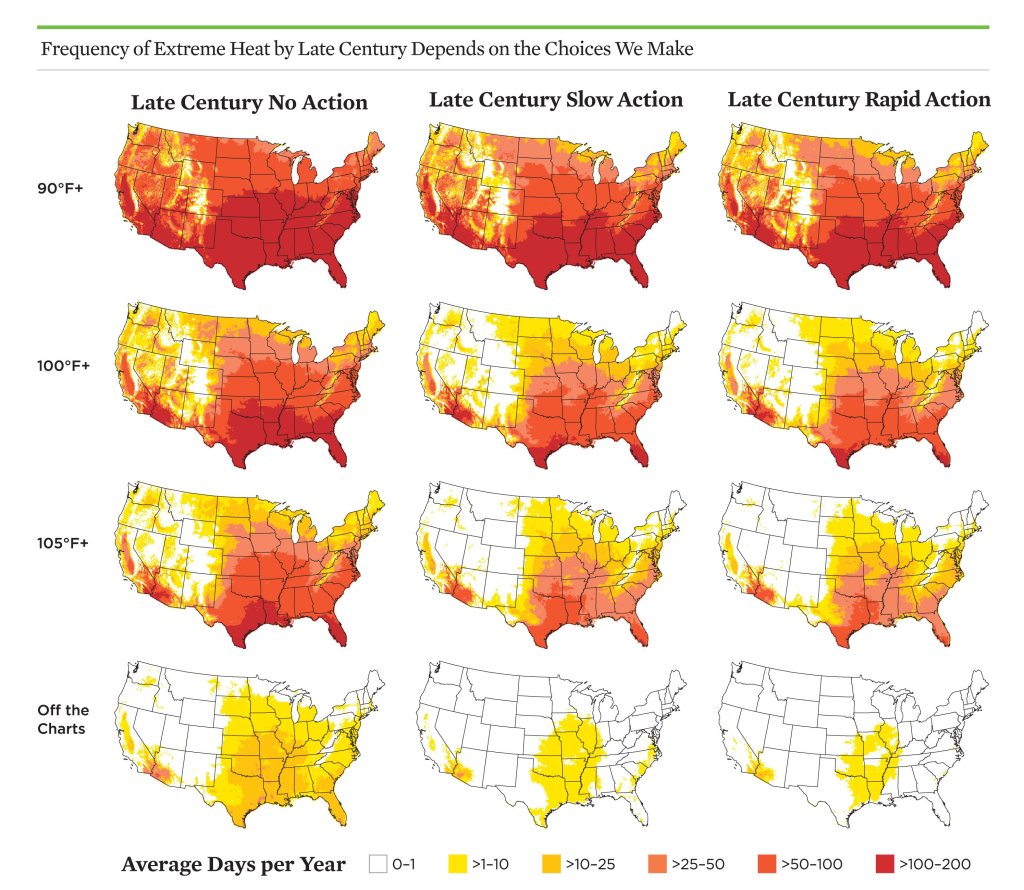
Extreme heat also stresses public infrastructure, particularly electrical systems, if people respond by cranking up their air conditioners, which increases carbon emissions and further exacerbates global warming.
Let’s looks at some strategies for cooler homes, workplaces, and communities.
Individual Buildings
There are numerous ways to improve building comfort and energy efficiency. Many of these strategies can be implemented in commercial as well as residential buildings.
An important first step is to limit the amount of sunlight, or solar gain, that enters a building. During a hot day, I often see homes with curtains drawn to block sunlight, but that’s too late; the heat has already entered the building. A far better approach is to install roof overhangs, awnings, and exterior curtains to shade windows during the hottest part of the day. Shaded porches help cool houses' interior sand provide comfortable places to socialize.
Before the advent of air conditioning, awnings and outdoor curtains were common, particularly for sun-oriented windows (south-facing in the Northern Hemisphere and north-facing in the Southern Hemisphere). It’s time to bring them back! Some awning are mechanical, extended during sunny periods and retracted when more sunlight is desired, but if correctly designed, permanent overhangs and awnings will block direct sunlight during the hottest part of the day and still allow plenty of light when the sun is low in the morning and late afternoon.
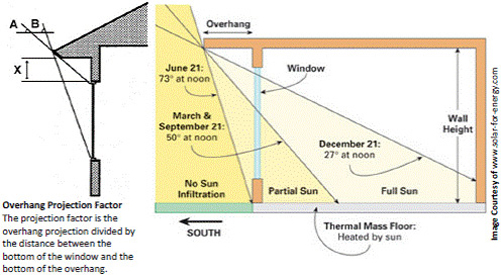
The illustration below shows the south face of a building near our home with well-designed awnings that shade the windows mid-day during summer, while still allowing plenty of natural daylight and views. However, they are the exception; few other building have awnings, making them uncomfortably hot on a sunny summer day.
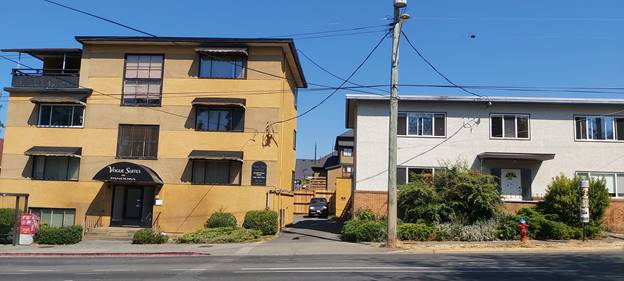
Modern mechanical awnings, exterior shades, and curtains can extend and retract at the push of a button, from inside the house, and can be programmed to do so automatically. They can be made of fabric, wood, or metal. Some smart manufacturer will make a fortune by producing such awnings with integrated solar panels so they require no wiring.
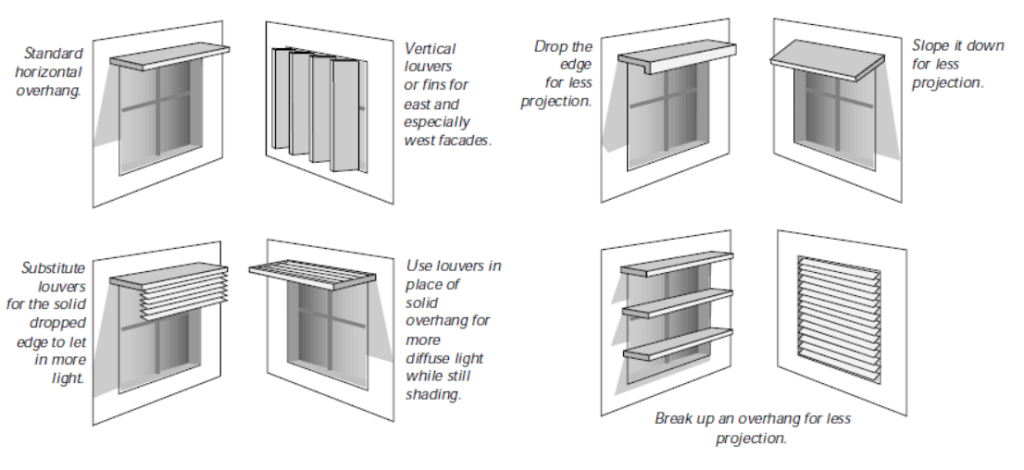
Old windows can be upgraded with multiple panes and reflective coatings that control solar gain and increase insulation. Low-E windows have low emissivity coating that block most ultraviolet (UV) and infrared (IR) light while allowing visible light to pass through. Windows are rated by the Solar Heat Gain Coefficient, which indicates the amount of solar heat it transmits (the lower the number, the less solar heat comes in), Visible Transmittance, which indicates the amount of natural light the window lets in during daytime (the higher the number, the more natural light enters), and the U-Factor, which measures its heat flow (the lower the number the better the window is at blocking heat). Well-designed windows can reduce heat gain and resulting air conditioning loads by an order of magnitude.
Buildings can be landscaped with trees, bushes or vines located to shade high-exposure areas to reduce solar gain. Deciduous trees are best in some locations because they provide shade during the heat of summer but allow sunlight to pass during winter and spring.
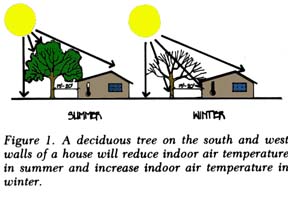
Exterior materials, including paints and roofing, can be selected to minimize heat absorption, called high albedo, measured using the Solar Reflectance Index (SRI). The lower the SRI, the hotter a surface will become in the sunshine.
Exterior walls and ceilings should be insulated to maintain cooling in the summer and heat in the winter. Many older buildings in warm climate areas have little or no insulation. It is important to install insulation correctly, with proper vapor barriers and ventilation, to prevent moisture accumulation that can cause mold and rot.
Buildings can be designed and modified to provide natural ventilation, enhanced where necessary with fans. Windows should be operable—i.e., they open—and designed to encourage cross drafts. This can be accomplished by having two operable windows on opposite walls and, because hot air rises, by having operable windows or skylights on different floors to take advantage of natural chimney effects.
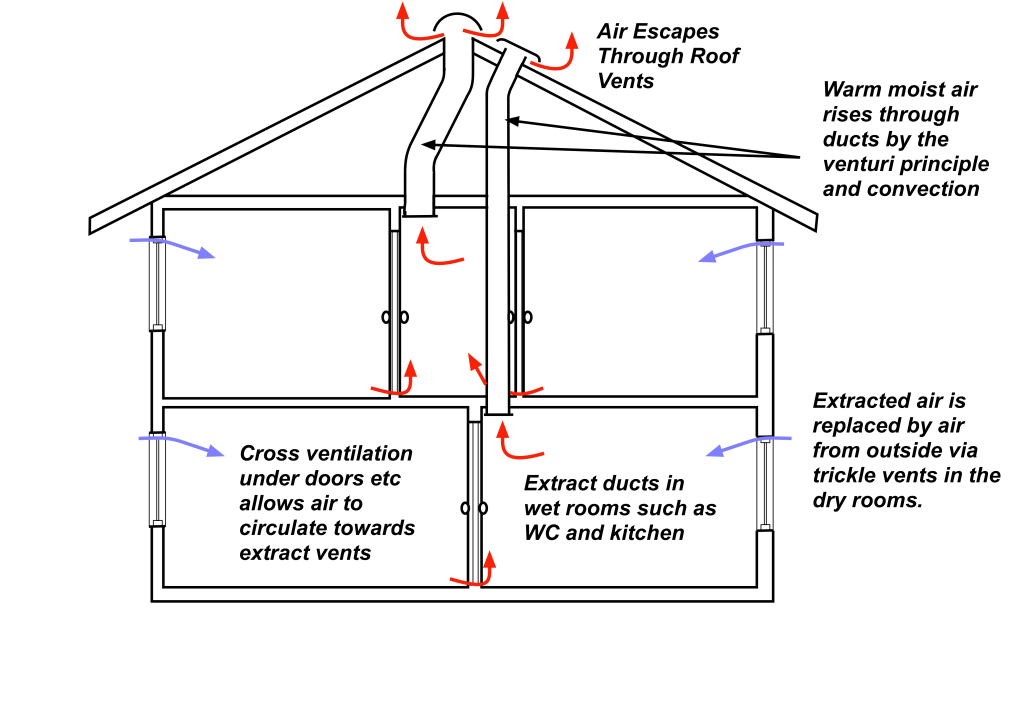
Mechanical air circulation systems can be programmed to bring cool air into buildings at night. They can include air-to-air heat exchangers that transfer the coolness of air conditioned spaces to fresh air as it enters a building, increasing energy efficiency.
To minimize interior heat gain, indoor lighting and appliances should be as energy efficient as possible. For example, replacing incandescent bulbs with more efficient lighting systems not only reduces lighting electrical consumption, it also reduces air conditioning loads. Similarly, energy-efficient appliances, cooking technologies and electronic devices provide additional energy and financial savings if they release less heat within the building envelopes. Some appliances, such as clothing washers and dryers and hot water tanks can be programmed to operate at night when they contribute less to building overheating and electricity prices are lower.
Air conditioning systems should also be selected and designed for maximum efficiency. Heat pump and air conditioning system efficiency is rated by the Seasonal Energy Efficiency Ratio (SEER), which indicates the average amount of cooling provided per unit of electricity used. Most older systems are energy hogs, with SEERs under 10. Since 2006, U.S. regulations mandated a minimum SEER of 13, and new systems are now available with SEERs over 20, more than twice as efficient as in the past.
Mechanical ventilation and air conditioning systems should be regularly inspected, cleaned and maintained. Air conditioning heat exchangers, where heat is released into the atmosphere, should be shaded and located to maximize air flow.
Lifestyle changes can also reduce cooling needs. More flexible dress codes that dispense with neckties, jackets, and tights, allow workspaces to be a few degrees warmer.
People sometimes assume that solar power can supply the electricity required for home cooling, but that is unrealistic if buildings are inefficient; too many panels would be needed to satisfy total energy needs unless a home is designed to maximize energy efficiency and minimize cooling loads.
According to the U.S. Department of Energy, households consume on average 11,000 kilowatt-hours (kWh) annually, of which 17% (about 2,000 kWh) is for air conditioning, as illustrated below. Of course, this is higher in hot climate regions and is likely to increase with global warming.
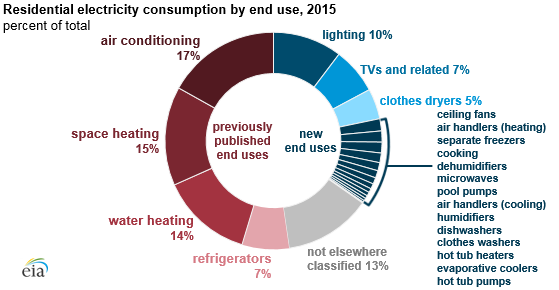
In hot climate areas, a typical small window air conditioner that cools just one room requires about 1,000 kWh, and a central air conditioner that cools an entire house requires 2,000 to 5,000 kWh.
A typical domestic solar panel produces 250-400 watts while the sun is shining, which totals about 500 total kWh per year. In hot climate regions, an average air conditioning system requires the electrical production of five to ten solar panels. A typical house roof can accommodate ten to 30 solar panels, producing 5,000 to 15,000 kWhs per year—more for larger houses with abundant solar exposure, fewer for smaller houses with partly-shaded roofs.
This suggests that conventional air conditioning loads will consume a major portion of a typical home’s solar power production. However, by reducing cooling loads and improving overall energy efficiency, a household can operate on a home’s solar electricity budget, becoming a net zero building or even contributing energy to the grid.
For example, smart shading and natural cooling practices, choosing high efficiency lighting and appliances can reduce electricity consumption and cooling loads by half. Choosing the most efficient air conditioner or heat pump can cut the remaining cooling costs in half again, so that the total 11,000 kWh demand is reduced to a manageable and affordable 3,000 to 5,000 kWh.
Community Actions
Public policies can help cool communities and reduce the problems of extreme heat.
The urban heat island effect refers to the increase in ambient temperatures caused by sunlight striking dark surfaces. The effect can increase urban areas daytime temperatures by 1–7°F, and nighttime temperatures by 2–5°F, compared with nearby greenspace, and tends to be particularly severe in lower-income, minority communities. This can make cities unpleasant and unhealthy, and increases cooling costs.
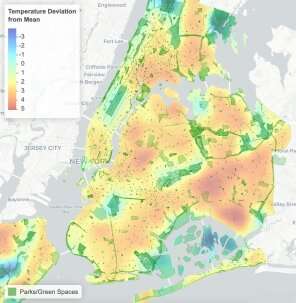
Communities can reduce the urban heat island effect by minimizing the amount of land that is paved for driveways and parking, shading these surfaces with landscaping or solar panels, and using more reflective materials such as concrete rather than asphalt. In some cases, buildings and parking structures can be designed with green roofs.
Governments can reduce total pavement area by designing narrower roads, eliminating parking minimums, more efficiently managing parking to reduce pavement area, and by planting trees and other landscaping to shade asphalt areas. Governments and utilities can mandate, encourage, and subsidize cool building designs including insulation, window shades, operable windows, appropriate landscaping and green roofs, and efficient appliances, including fans, air conditioners and heat pumps.
It is important to shade areas where people walk and wait outdoors, such as sidewalks and bus stops.
Communities can also establish extreme heat protocols to reduce the discomfort and risks during heat events. This can include, for example, providing cooling stations for residents and workers, misting hot areas where people walk and work, and providing water, fans or air conditioners to low-income households that need them.
Public policies should strive to minimize electricity consumption and total energy costs (dollars per capita), which often requires increasing electricity rates (cents per kWh) because expensive electricity motivates consumers to implement cooling strategies. For example, to support energy conservation, jurisdictions can tax electricity and use the revenues to subsidize private and public energy efficiency programs, so as rates increase, energy use and costs decline. Such taxes can be designed with exemptions or rebates for lower-income households. Special policies and subsidies are required for rental buildings, since landlords have little incentive to invest in cooling improvements if tenants foot the electricity bill.
Many of these strategies provide significant co-benefits. For example, reducing road and parking supply with more efficient traffic and parking management helps reduce infrastructure costs and traffic problems, and by reducing impervious surface area it reduces stormwater management costs. Planting more urban shade trees helps create more attractive neighborhoods and increase wildlife habitat. Improving natural ventilation creates more comfortable and healthier buildings, as summarized below.
Cool Community Strategies and their Co-Benefits
Strategy |
Co-Benefits |
|
Plant more shade trees, particularly over homes, streets and parking lots. |
More indoor and outdoor comfort. Increased beauty. Wildlife habitat. |
|
Use overhangs, awnings, exterior shades and reflective window glass on sun-oriented windows to reduce interior solar gain. |
More indoor comfort. |
|
Design buildings with operable windows and vents to provide natural ventilation. |
More indoor comfort and health. |
|
Reduce impervious surface area. Construct more compact buildings, and reduce pavement area with narrower streets, and fewer, smaller driveways and parking lots. |
More efficient land consumption. More greenspace and habitat. Reduced stormwater management costs. Reduced sprawl costs. |
|
Use more reflective (higher albedo) materials for roofs, roads, paths and parking lots. |
|
|
Insulate walls to reduce indoor heat gain. |
Energy conservation and cost savings. |
|
Use high efficiency lighting and appliances inside buildings to minimize heat gain. |
Energy conservation and cost savings. |
|
Use fans where needed to provide adequate ventilation. |
More indoor comfort. |
|
Use state-of-art air conditioners, designed, programmed and maintained for maximum efficiency. |
Energy conservation and cost savings. |
|
Raise energy rates and subsidize energy efficiency programs. |
Energy conservation and total cost savings. |
|
Extreme heat response protocols. |
In cold climate regions, building weatherization is a major industry. Contractors identify each particular building's sources of heat loss, sometimes using technologies such as infrared cameras and blower doors, develop a targeted plan to reduce them, and deploy expert teams who install weather stripping and insulation, replace old windows, and install more efficient heating systems. These investments create more comfortable homes and usually repay their costs within a few years.
It’s time to create similar industries in hot climate regions to reduce heat risks and cooling costs. These can use similar methods to make existing homes and communities more comfortable and affordable during hot weather.
Cool community planning is a hot issue! All planners should become familiar with cool community design concepts, and some should become specialists. If I were an entrepreneur, I would establish a network of cool community weatherization businesses and produce the specialized products they need to comfortably and efficiently respond to rising temperatures.
For More Information
International Green Roof Association is a global network for the promotion and dissemination of Green Roof topics and technologies.
Todd Litman (2022), Pavement Buster’s Guide: Why and How to Reduce the Amount of Land Paved for Roads and Parking Facilities, Victoria Transport Policy Institute.
Reduce Urban Heat Island Effect, U.S. EPA website.
Smart Surfaces Coalition promotes the use of reflective and impervious surfaces, solar panels, green roofs, trees and rain gardens in urban areas to reduce heat island effects.
Streetspace Allocation Option Generation Tool, helps redesign, reallocate, or regulate streetspace to meet specific community policy goals, including reduced pavement.
Theresa Tam (2020), Reducing urban heat islands to protect health in Canada. An introduction for public health professionals. Government of Canada.
What is the Heat Island Effect? - Planetizen Planopedia.
Whole Building Design Guidelines provides comprehensive information for optimizing building efficiency, including cooling.

Planetizen Federal Action Tracker
A weekly monitor of how Trump’s orders and actions are impacting planners and planning in America.

Chicago’s Ghost Rails
Just beneath the surface of the modern city lie the remnants of its expansive early 20th-century streetcar system.

Amtrak Cutting Jobs, Funding to High-Speed Rail
The agency plans to cut 10 percent of its workforce and has confirmed it will not fund new high-speed rail projects.

Ohio Forces Data Centers to Prepay for Power
Utilities are calling on states to hold data center operators responsible for new energy demands to prevent leaving consumers on the hook for their bills.

MARTA CEO Steps Down Amid Citizenship Concerns
MARTA’s board announced Thursday that its chief, who is from Canada, is resigning due to questions about his immigration status.

Silicon Valley ‘Bike Superhighway’ Awarded $14M State Grant
A Caltrans grant brings the 10-mile Central Bikeway project connecting Santa Clara and East San Jose closer to fruition.
Urban Design for Planners 1: Software Tools
This six-course series explores essential urban design concepts using open source software and equips planners with the tools they need to participate fully in the urban design process.
Planning for Universal Design
Learn the tools for implementing Universal Design in planning regulations.
Caltrans
City of Fort Worth
Mpact (founded as Rail~Volution)
City of Camden Redevelopment Agency
City of Astoria
City of Portland
City of Laramie






























